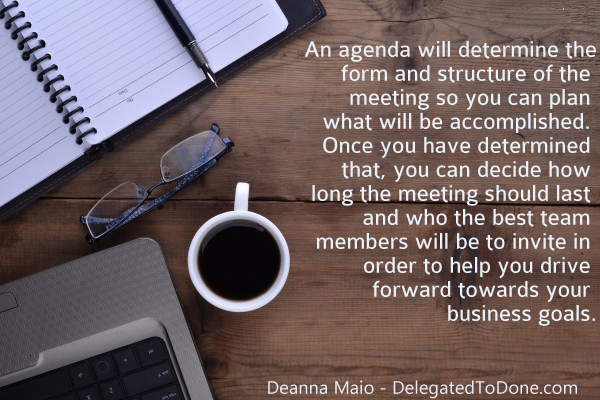Creating an agenda is crucial to the success of any business meeting. An agenda will determine the form and structure of the meeting so you can plan what will be accomplished. Once you have determined that, you can decide how long the meeting should last and who the best team members will be to invite in order to help you drive forward towards your business goals.
We’re all so busy at work these days, it can be easy to get swamped to the point where any meeting feels like an unwelcome intrusion on your day. There’s nothing worse than having the work pile up while you’re stuck in a boring meeting that seems to last forever and go nowhere.
A meeting agenda can ensure that your meetings are not dull and take all the participants where they need to go. The more focused the agenda, the more effective the meeting will be. The more effective the meeting, the more likely that the participants will feel energized about the tasks at hand and eager to complete them. They will also be more likely to take the necessary follow up steps that will make it truly productive.
There are several key elements to a good meeting agenda:
Topic
Your agenda should literally put everyone invited on the same page. Any meeting you hold should be results-driven. Start by setting the topic of your meeting. What will it be about?
Goal/s
Set at least one clear goal for each meeting. Do you want to start a new project, get a status check, or hold a brainstorming session? These goals will help you decide how long the meeting should be and where it will be held.
Objectives
Once you have set the overall goal of each meeting, determine your objectives. For example, if this meeting might be one of several in reference to a new project, have clear goals and objectives for each meeting in the series.
The goals and objectives of the first meeting will naturally be to introduce all those invited to the new project and set assignments, that is, smaller tasks and goals, which will all contribute to achieving the larger goal.
Non-objectives
Once you have determined the objectives, you should also consider non-objectives. For example, if you really need to push forward a particular project, then batting ideas back and forth in a brainstorming session is not going to be a productive use of anyone’s time.
It is fine for people to report back about any issues they may be concerned about when giving a progress check, but the important thing will be to keep everyone focused on the agenda given for each meeting.
Inviting stakeholders
Once you have chosen the goal and topic of the meeting, it will be time to select the key stakeholders who should be attending. They should all be able to contribute to the goals and objectives on your agenda.
Sharing essential information
Once you have invited stakeholders, give them whatever essential information they need to know about upfront. This can help them ‘do their homework’ before the meeting ever starts. Thanks to a clear agenda and detailed information, the meeting will have momentum and keep everyone on task.
Use Your Agenda as a Checklist
Have a copy in front of you to make sure you cover everything on the agenda. If you run out of time, carry any items forward to the next meeting.
[Tweet “Plan your agenda first before you ever think about holding a meeting, and your meetings will be far more successful. https://www.delegatedtodone.com/what-is-the-importance-and-purpose-of-a-meeting-agenda”]

